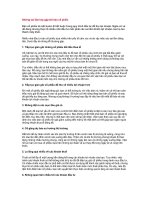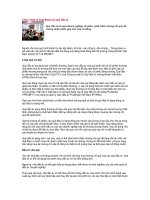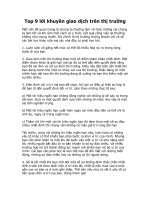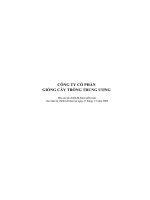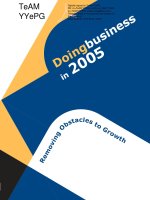Tài liệu Wiley Private Equity, Transforming Public Stock To Create Value ppt
Bạn đang xem bản rút gọn của tài liệu. Xem và tải ngay bản đầy đủ của tài liệu tại đây (2.28 MB, 213 trang )
equity
Transforming Public Stock
to Create Value
HAROLD BIERMAN, JR.
John Wiley & Sons, Inc.
equity
Founded in 1807, John Wiley & Sons is the oldest independent publishing
company in the United States, With offices in North America, Europe, Aus-
tralia, and Asia, Wiley is globally committed to developing and marketing
print and electronic products and services for our customers' professional
and personal knowledge and understanding.
The Wiley Finance series contains books written specifically for finance
and investment professionals as well as sophisticated individual investors
and their financial advisors. Book topics range from portfolio management
to e-commerce, risk management, financial engineering, valuation, and fi-
nancial instrument analysis, as well as much more,
For a list of available titles, please visit our web site at www.Wiley
Finance.com,
equity
Transforming Public Stock
to Create Value
HAROLD BIERMAN, JR.
John Wiley & Sons, Inc.
Copyright © 2003 by Harold Bierman, Jr. All rights reserved.
Published by John Wiley & Sons. Inc., Hoboken, New Jersey.
Published simultaneously in Canada.
No part of this publication may be reproduced, stored in a. retrieval system, or
transmitted in any form or by any means, electronic, mechanical, photocopying,
recording, scanning, or otherwise, except as permitted under Section 107 or 108
of the 1976 United States Copyright Act. without either the prior written
permission of the Publisher, or authorization through payment or the appropriate
per-copy fee to the Copyright Clearance Center. Inc., 222 Rosewood Drive,
Danvers, MA 01923, 978-750-8400, fax 978-750-4470, or on the Web at
www.copyright.com. Requests to the Publisher for permission should be addressed
to the Permissions Department, John Wiley & Sons, Inc., 111 River Street,
Hoboken, N] 07030, 201-748-6011, fax 201-748-6008. e-mail:
Limit of Liability/Disclaimer of Warranty: While the publisher and author have
used their best efforts in preparing this book, they make no representations or
warranties with respect to the accuracy or completeness of the contents of this
book and specifically disclaim any implied warranties of merchantability or fitness
for a particular purpose. No warranty may be created or extended by sales
representatives or written sales materials. The advice and strategies contained
herein may not be suitable for your situation. You should consult with a
professional where appropriate, Neither the publisher nor author shall be liable
for any loss of profit or any other commercial damages, including but not limited
to special, incidental, consequential, or other damages.
For general information on our other products and services, or technical support,
please contact our Customer Care Department within the United States at 800-
762-2974, outside the United States at 317-572-3993 or fax 317-572-4002.
Wiley also publishes its books in a variety of electronic formats. Some content that
appears in print may not be available in electronic books.
For more information about Wiley products, visit our web site at www.wiley.com.
Library of Congress Cataloging-in-Publication Data:
Bierman, Harold.
Private equity : transforming public stock to create value / Harold Bierman, jr.
p. cm.
ISBN 0-471-3.9292-8 (cloth : alk. paper)
1. Corporations—Valuation. 2. Private equity. 3. Going private
(Securities) 4. Corporations.... Finance. 5. Leveraged buyouts.
6. Venture capital. I. Title.
HG4028.V3 B445 2003
338.6'041--dc21
2002013636
Printed in the United States of America.
10 9 8 7 6 5 4321
contents
Preface
ix
Acknowledgments
xi
CHAPTER 1
The Many Virtues of Private Equity
1
CHAPTER 2
Valuing the Target Firm
7
CHAPTER 3
Structuring and Selling the Deal
25
CHAPTER 4
A Changed Dividend Policy
35
CHAPTER 5
A Changed Capital Structure
47
CHAPTER 6
Merchant Banking
67
CHAPTER 7
Operations: The Other Factor
79
CHAPTER 8
The Many Virtues of Going Public
85
CHAPTER 9
A Partial LBO: Almost Private Equity
91
CHAPTER 10
Metromedia (1984)
101
vii
viii
______________________________________________________
CONTENTS
CHAPTER 11
LBO of RJR Nabisco (1988)
107
CHAPTER 12
Marietta Corporation (1994-1996)
115
CHAPTER 13
The Managerial Buyout of United States Can Company (2000)
127
CHAPTER 14
Phillips Petroleum, Mesa, and Icahn (1984-1985)
137
CHAPTER 15
Owens-Corning Fiberglas Corporation (1986)
143
Solutions
155
References
185
Index
189
ublic corporations have many different types of investors,
each type having a different financial objective. The primary
objective of private equity is that the stockholders are likely to have
similar financial objectives and it is much easier for the
corporation's financial strategies to be consistent with these
objectives.
Private equity frequently is associated with a leveraged buyout.
The equity ownership of a public corporation is changed to equity
that is not traded in a public market. There are significant financial
advantages and there are also operational advantages. For example,
management frequently becomes an owner of a significant amount
of the equity and thus the interests of management and the owners
become more convergent. Most importantly, the common stock-
holders can directly and effectively affect the corporate financial de-
cisions.
The concepts of this book are important to investors interested
in increasing their rates of return on their investments, without in-
creasing their risk and to management interested in supplementing
their wages with a significant share of the firm's profitability.
Harold Bierman, Jr.
Cornell University
Ithaca, NY
ix
P
ill Kidd, Jim Hauslein, and Hall Wendel, practitioners of the art
of private equity, helped educate me.
Sy Smidt and Jerry Hass, co-authors in other books, developed
many of the ideas contained in this book.
I thank Diane Sherman for her typing efforts through many
drafts of this book.
xi
B
The Many Virtues
of Private Equity
or purposes of this book the term private equity refers to the
common stock of a corporation where that common stock is
held by a relatively few investors and is not traded on any of the
conventional stock markets. Normally the senior managers of
the firm hold a significant percentage of the firm's stock, and we
will assume that is the situation in all the cases discussed in this
book.
In practice, the term private equity is used in several different
ways. There are private equity investment firms that direct their
clients' funds into mutual funds or to other money managers.
There are even private equity funds that invest directly into pub-
licly owned corporations, usually concentrating the investments
into a few corporations.
Venture capital is a form of private equity. In this book the use of
the term will be restricted to the investment in the equity of corpora-
tions that are, or will soon be, not publicly owned. An exception is
the case of a partial leveraged buyout (LBO). This is almost private
equity but the firm is still publicly traded.
Megginson, Nash, and vanRadenborgh (1996) offer a review of
the history of privatization. Jensen (1993) covers the general issue of
corporate control. Kleiman (1988) studied and reports the gains
from LBO types of transactions.
What are the advantages of private equity?
1
F
2
__________________________________________________
PRIVATE EQUITY
SIMPLICITY_______________________________
Because there are no public equity investors the private equity firm's
financial reporting requirements to all the relevant governmental en-
tities are reduced. This simplifies management's responsibilities and
results in transaction cost savings for the firm.
With private equity there are no requirements that management
keep Wall Street informed of the firm's expected earnings and then
provide an explanation of the actual earnings and why they differ
from the expected earnings. Decisions are not affected by short term
earnings and the anticipated stock market's reactions to the earn-
ings; thus the firm's decision making may be improved.
The firm's board of directors can be chosen for effectiveness
rather than appearances or public relations.
ALIGNMENT OF MANAGEMENT AND
OWNERSHIP
With the average publicly held firm the interests of management and
the firm's ownership are not always perfectly aligned. An entire area
of study called agency theory has been created with the objectives of
studying and reducing the conflicts between a firm's management
and its owners. The classic papers on agency theory are Jensen and
Mecking (1976) and Jensen (1986).
We assume the common stock of the private equity firm dis-
cussed in this book is to a significant extent owned by management.
Management has an incentive to act in a manner consistent with
maximizing the well-being of the equity owners.
DIVIDEND POLICY OF A PRIVATE EQUITY FIRM
The owners of a private equity firm tend to be paid for their services
as members of management, consultants, or members of the firm's
board of directors. They also hope for a value accretion to their
stock holdings.
If the owners are also employees of the firm, the incomes earned
for services will be taxed at ordinary income tax rates. But there is
The Many Virtues of Private Equity
3
only one level of tax since the corporation gets a tax deduction for
the amounts paid for service. This is the first tax advantage.
The gain from the value accretion of the stock will be taxed in
the future at a capital gains rate when the gain is realized for tax
purposes. Thus there are two tax advantages from value accretion
and the use of private equity; one is tax deferral and the second is
the lower capital gains tax rate compared to the tax rate on ordi-
nary income.
The private equity firm has little or no incentive to pay cash div-
idends on the common stock. The investors would rather be paid as
employees or have their equity investment gains be converted into
capital gains and have these gains taxed at the lower capital gains
tax rate in the future.
CAPITAL STRUCTURE
_____________________
The normal public corporation has managers and owners. While the
managers may also be stockholders, the total value of their stock in-
vestment in the corporation tends to be much less than the present
value of their salaries and bonuses. The senior managers of public
corporations have a significant incentive to act in such a way as to
not jeopardize the stream of salaries that will be earned if the man-
agers are not dislodged from their jobs.
With a private equity firm the relative values of salaries and
ownership are changed. Now the owners have an incentive to sub-
stitute debt for equity both to gain (or maintain) control and to add
value. The use of debt becomes a much more important tool for
adding value with a private equity firm than with a public firm.
VENTURE CAPITAL
_______________________
This is not a book on venture capital though many of the conclu-
sions of this book apply equally to venture capital activities, since
venture capital is a form of private equity.
It is assumed in this book that the firm being taken private has
a track record and its value can be estimated based on objective
4
__________________________________________________
PRIVATE EQUITY
financial measures of the results of operations. Frequently, a ven-
ture capitalist is evaluating the story told by an entrepreneur.
While there may be projected financial results, they frequently are
not backed up by actual results. The valuation of such a firm is
more an art than a science.
MBOs
_______________________________
DeAngelo and DeAngelo (1987) review the early history of manage-
rial buyouts (MBOs). From 1973-1982 they identify 64 buyout
proposals made by managers of New York and American Stock Ex-
change listed firms. They identify eight factors that are important in
the decision to effect a management buyout. These are:
1. Potential improvement in managerial incentives
2. Save costs of disseminating information to stockholders
3. Company secrets are better protected
4. Tax savings of interest tax shields and other tax savings
5. Avoidance of hostile takeovers
6. Difficulty to raise capital
7. Illiquid stock (leading to greater difficulty attracting managers)
8. Disagreements among stockholders (because of illiquid in
vestments)
Diamond (1985) put together a team of practitioners of the
LBO art to construct a book that explores the legal, tax, account-
ing, operational, and financial considerations of an LBO transac-
tion. It is a handy reference book regarding the practical aspects of
the LBO deal.
THE J.P. MORGAN CHASE FUND
____________
In February 2001 J.P. Morgan Chase announced that its J.P. Mor-
gan Partners unit was raising $13 billion for a private equity fund
(see the Wall Street Journal of February 6, 2001). While $8 billion
was to be the bank's own funds, $5 billion was to be raised from
The Many Virtues of Private Equity
5
other investors. These investors were to include pension funds, uni-
versity endowments, and foundations. This fund raising effort fol-
lowed the creation within a few months of Thomas Lee's $6.1
billion buyout fund and KKR's raising of a $6 billion fund.
Private equity funds primarily invest in leveraged buyouts but
they are not precluded from investing in venture capital activities.
Their main investment destination is the LBO but private equity in-
vestment can take many different forms.
J.P. Morgan Chase and its predecessors investing in private eq-
uity had earned a 40 percent annual return on equity capital. To
evaluate this return we would need to know the amount of debt and
other senior securities used, as well as the status and age of deals
that have been undertaken, but are not yet completed (thus there is
not yet an objective measurable internal rate of return). Also, the 40
percent return was earned on a smaller amount of capital than was
now being raised. Investing a large sum of capital in firms of larger
size has its own set of challenges for a private equity operation. The
number of eligible targets is reduced. On the other hand the number
of firms competing for those larger targets is also reduced.
CONCLUSIONS
__________________________
There are several reasons why value may be added by a firm con-
verting from being organized as a publicly owned firm to be a pri-
vate equity firm. First, there are operational reasons why a private
equity firm may have more value. Second, two financial decisions
(dividends and capital structure) are likely to be different with a pri-
vate equity firm than with a publicly owned firm. The set of finan-
cial decisions with the private equity firm is likely to add value to
the investors owning the stock.
QUESTIONS AND PROBLEMS
_______________
1. What are the advantages of private equity?
2. Of the eight factors listed by DeAngelo and DeAngelo, which
one do you consider most important?
6
__________________________________________________
PRIVATE EQUITY
3 a. Assume the LBO management firm is paid 2 percent on Com-
pany B's total assets and 20 percent of the gross profits (before
capital charges and after taxes). The capital structure for Com-
pany B is:
Dollars
Debt (.14) $40
Preferred (.12) 30
Convertible preferred (.06) 20
Equity 10
Company B has a .35 tax rate. It earned $90 before interest be-
fore taxes before management charges.
Required: Allocate the $90.
3b. Now assume the firm earns $45 before interest, taxes, and man-
agement changes.
Required: Allocate the $45.
Valuing the Target Firm
side from venture capital situations and restructuring efforts, pri-
vate equity capital firms tend to invest in either a leveraged buy-
out (LBO) or a management buyout (MBO). Either of these two
buyouts (differing only to the extent of the magnitude of manage-
ment's participation in the new equity split) may be facilitated by a
merchant bank, which would supply some of the equity capital and
possibly other types of capital. Merchant bankers or their equivalent
have to set a value on the firm that is being converted to a private
equity capital firm.
The valuation of a firm for the purpose being discussed is anal-
ogous to the familiar capital budgeting type of problem, but differs
in several ways. Usually the target firm has a track record of gener-
ating cash flows; thus there is a sound objective basis for estimat-
ing the future cash flows. Secondly, the people buying the equity of
a firm distrust a process that relies excessively on the forecast of
the future cash flows. While any valuation process implicitly is
forecasting the future cash flows, the extent of the forecasting may
be less obvious when the buyer is using some calculation tech-
niques compared to other techniques. Of course, when the buyer is
computing the valuation of a firm, the current owners of the firm
are also computing the value. If the buyer computes the firm's
value to be larger than the seller's estimate, the likelihood of a sale
of the firm increases.
First, we consider a value measure that is completely objec-
tive and then we review measures that become more and more
subjective.
A
8
__________________________________________________
PRIVATE EQUITY
MARKET CAPITALIZATION
In some situations the only completely objective value measure is
the market capitalization. This is equal to the number of outstand-
ing shares of common stock times the market price per share, as-
suming the market price is observable and there are no complexities
in computing the number of outstanding shares. Any acquirer
would have to expect to pay a premium to the current market capi-
talization. The market value of the common stock sets a floor for an
offering price by a buyer. Rarely would a buyer consider submitting
a bid less than current market price and expect to acquire a majority
of the outstanding shares. In fact, one would expect the acquirer to
have to pay a premium over the market price. Thus the market price
of the common stock is an important measure of value since it sets a
minimum-offering price.
It can be argued that, with a closely held corporation, if the
stockholders desire to unload their stock, they may not be able to,
because the market is too thin. In such a situation the seller might ac-
cept the market price or even marginally less than the market price,
since the market price does not fairly represent the firm's value.
Can one obtain the value of the stockholders' equity by using
the market value for a few shares traded on the stock market? It
should be remembered that the entire universe of investors is avail-
able as possible purchasers of the stock and that the present owners
are not bidding up the stock price to acquire more shares. Normally
it will not take a large price increase to cause the present investors
to sell their shares of stock assuming the price before the bid was set
by the market. Premiums paid by the acquirers in most deals are less
than .30.
MULTIPLIERS
___________________________
The use of multipliers for valuation is common practice. A multi-
plier is applied to some type of flow measure. The multiplier is fre-
quently based on the observed relationships of comparable firms.
The following multipliers are used:
Valuing the Target Firm
9
■ Price-earnings multiplier.
■ Cash flow multiplier (EBITDA and free cash flow multipliers).
EBITDA is earnings before interest, taxes, depreciation, and
amortization.
Free cash flow is cash flow from operations after maintenance
capital expenditures. Sometimes free cash flow is computed
after all investment outlays.
■ Cash flow multipliers applied to the next period's flows (e.g.,
NEBITDA).
If one takes the current earnings and multiplies by the cur-
rent price-earnings multiplier, one obtains the current market
price. The expected earnings of the current year or an adjusted
earnings can be used rather than the observed earnings of the past
year. Another variation is to use the expected earnings of the next
year.
The use of the expected earnings times a price-earnings mul-
tiplier is a common technique for evaluating prospective acqui-
sitions. It may be a shortcut method of applying discounted
cash flows. The following mathematical model illustrates this
position.
